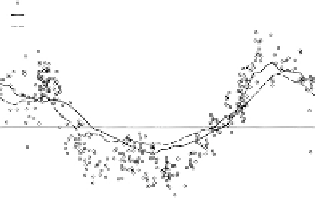Geoscience Reference
In-Depth Information
N
250
Aug. 20, 1977
8
W
E
200 m/s
0
9
10
15
July 81-Feb. 83 DE-2 wind velocity
1978 1981
1970 1971
11 UT
14
250
200
Jicamarca plasma drift
13 12
16
50
S
150
100
N
50
0
2
50
Aug. 21, 1977
2
50
10
100
9
W
E
200 m/s
2
100
0
8
11 UT
2150
12
14
13
00
04
08
12
16
20
24
50
15
Local time (75
8
W)
S
(a)
(b)
Figure 3.6
(a) Position of the tip of the neutral wind vector measured over Kwajalein as
a function of universal time on August 20 and 21, 1977. The dashed circle indicates the
15m/s uncertainty in the determination. [After Sipler and Biondi (1978). Reproduced with
permission of the American Geophysical Union.] (b) Comparison of the Jicamarca average
drifts with thermospheric wind data from DE-2. [After Fejer et al. (1985). Reproduced
with permission of the American Geophysical Union.]
Although the winds display a high degree of variability from day to day, to a first
approximation the winds are eastward and quite strong (
∼
150m/s) in the post-
sunset period, decaying in amplitude to less than 50m/s after midnight. More
recent airglow observations in the Peruvian sector are in good agreement with
these data (Meriwether et al., 1986).
Airglow observations are restricted to nighttime, but satellite observations
have yielded full 24 h coverage of the thermospheric winds (Wharton et al.,
1984). Some of these data are presented in Fig. 3.6b, superimposed on the
Jicamarca zonal plasma drift pattern. Both are clearly diurnal, with larger winds
and plasma drifts occurring at night. There is a lot of scatter in the winds mea-
sured by the satellite, but the pattern is unmistakable, as is its correlation with
the plasma drifts.
Setting aside the superrotation phenomenon for the moment, we can ask
whether forcing due to solar heating of the thermosphere can explain the high
winds observed in the postsunset period. Since the Coriolis force vanishes at the
equator, in a steady state the winds should blow in the
p
direction from west
to east across the sunset terminator. This pressure gradient is due to the subsolar
neutral atmospheric temperature bulge that occurs on the sunward side of the
earth. The problem is not so much the direction of the wind, which agrees with
the data, but the magnitude of the theoretically calculated winds - the initial
estimates of the wind speed were too high (Lindzen, 1966).
−∇




































Search WWH ::

Custom Search